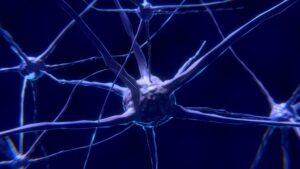

Chronic pain falls into a number of categories. Two major categories are Nociceptive and Neuropathic pain. Further classification depends on where the pain is located and what is causing it (i.e. cancer-related, musculoskeletal, somatic or visceral, etc). Many chronic painful conditions will involve mixed nociceptive/neuropathic/other pain types. In this article, we briefly explain the differences between the two major categories of pain and expand on neuropathic pain.
Nociceptive pain is pain due to tissue damage. Nociceptors are sensory nerve cells residing in tissues, particularly the skin. They detect and respond to tissue damage and dangerous signals that may lead to tissue damage, such as extreme temperature, pressure, chemicals and toxins. They transmit signals to the central nervous system to evoke the sensation of pain.
Nociceptive pain typically results from an injury, such as a wound, burn, bruise, sprain, fracture, and so forth. The clinical characteristics of nociceptive pain depend on the source of the pain and may be described as:
Most cases of nociceptive pain are acute, usually resolving over time as the body heals the damaged tissue; however, nociceptive pain may also be chronic. Chronic nociceptive pain may be due to arthritis, osteoporosis or cancer, for example.
Neuropathic pain is pain due to damage to or dysfunction of the somatosensory nervous system (which is part of the nervous system that responds to sensory information on the outside and inside of the body, such as touch, temperature, pressure and pain). A simplified, older definition, is pain due to nerve trauma or dysfunction (i.e. “nerve pain”).
Neuropathic pain can be due to direct injury to or irritation of a nerve, spinal cord injury, spinal disease or degeneration, chronic inflammation, cancer, chemotherapy, virus activity, dietary factors, just to name a few. In some cases, neuropathic pain may develop without any obvious cause.
Neuropathic pain is associated with “new and strange sensations”. Clinical characteristics of neuropathic pain include:
There are numerous conditions that have a major or significant neuropathic pain component. Below are some examples.
Peripheral neuropathy is a term used to describe a range of conditions in which peripheral nerves (outside of the central nervous system) behave abnormally due to some form of nerve damage/trauma/irritation. This may be caused by some underlying condition or disease (e.g. diabetes, cancer, virus infection), or it could be a side effect of prolonged exposure to some drug/treatment (e.g. chemotherapy), or even dietary factors (e.g. alcoholism, vitamin deficiency). Peripheral neuropathy is often associated with pain. Specific examples of peripheral neuropathies are:
Chronic low back / leg pain typically involves a mixture of pain types. The nociceptive pain component may be the result of injury, stress and/or inflammation to the muscles, joints, ligaments, tendons or fascia within and around the spine. There may not be a neuropathic pain component, but if there is, it could be the result of injury, irritation and/or inflammation to the spinal nerve roots or the discs, which may be due to or complicated by an underlying disease.
Neuropathic pain conditions involving the somatosensory system of the central nervous system include post-stroke pain and spinal cord injury-related neuropathic pain.
The most common symptoms of neuropathic pain, as listed above, are: burning pain, electric shock-like pain, prickling or tingling pain (i.e. pins and needles – aka paraesthesia) and numbness.
Signs of neuropathic pain that can be assessed by a physician during a physical examination include the following:
Several questionnaires have been developed for the purpose of specifically identifying neuropathic pain, such as the following:
Whilst not specific for neuropathic pain, several clinical or laboratory diagnostic tools have been developed as methods of assessing nervous system dysfunction, such as:
Ultimately, treatment of neuropathic pain depends on the cause / specific condition and whether the condition involves mixed pain types and multiple/complex disease mechanisms. Chronic pain management generally requires a multi-treatment, multi-disciplinary approach. The following treatment options are designed to treat neuropathic pain specifically.
The following drugs are recommended for treatment of neuropathic pain:
The use of opioids is controversial, namely due to their side effects and the lack of evidence to support their long-term effectiveness. Tramadol is an atypical opioid that may be useful.
Physical therapy and rehabilitation techniques, along with psychological support, if necessary, are important in the multimodal management of neuropathic pain, especially when medications are inadequate. Therapies that may be useful for neuropathic pain, depending on the specific condition, include:
Where medications and conservative therapies fail to help with neuropathic pain, certain interventional procedures may be considered, depending on the specific condition.
Genesis Research Services conducts clinical trials for patients with neuropathic pain. If you live with neuropathic pain and are interested in participating in a clinical trial, click here to view our current studies or call us on (02) 4985 1860. If the current studies aren’t suitable for you, you may register your interest for future studies.
1. Healthdirect. “Neuropathy”. https://www.healthdirect.gov.au/neuropathy
2. International Association for the Study of Pain (IASP). “Neuropathic Pain”. http://www.iasp-pain.org/Advocacy/GYAP.aspx?ItemNumber=5054
3. PainAustralia. “Neuropathic (Nerve) Pain”. http://www.painaustralia.org.au/about-pain/forms-of-pain/neuropathic
4. Akyuz G & Kenis O. “Physical therapy modalities and rehabilitation techniques in the management of neuropathic pain”. International Journal of Physical Medicine and Rehabilitation 2013; 1:4. https://www.omicsonline.org/physical-therapy-modalities-and-rehabilitation-techniques-in-the-treatment-of-neuropathic-pain-2329-9096.1000124.php?aid=13652
5. Baron R, et al. “Neuropathic low back pain in clinical practice”. European Journal of Pain 2016; 20:861-73. https://www.ncbi.nlm.nih.gov/pmc/articles/PMC5069616/
6. Callin S & Bennett MI. “Assessment of neuropathic pain”. Continuing Education in Anaesthesia Critical Care & Pain 2008; 8:210-213. https://academic.oup.com/bjaed/article/8/6/210/405993
7. Colloca L, et al. “Neuropathic pain”. Nature Reviews. Disease Primers 2017; 3: 17002. https://www.ncbi.nlm.nih.gov/pmc/articles/PMC5371025/
8. Cruccu G & Truini A. “Tools for Assessing Neuropathic Pain”. PLoS Medicine 2009; 6:e1000045. https://www.ncbi.nlm.nih.gov/pmc/articles/PMC2661248/
9. Cruccu G & Truini A. “A review of Neuropathic Pain: From Guidelines to Clinical Practice”. Pain and Therapy 2017; 6:35-42. https://www.ncbi.nlm.nih.gov/pmc/articles/pmid/29178033/
10. Dubin AE & Patapoutian A. “Nociceptors: the sensors of the pain pathway”. The Journal of Clinical Investigation 2010; 120:3760-72. https://www.ncbi.nlm.nih.gov/pmc/articles/PMC2964977/
11. Finnerup NB, et al. “Neuropathic pain: an updated grading system for research and clinical practice”. PAIN 2016; 157:1599-606. https://journals.lww.com/pain/fulltext/2016/08000/Neuropathic_pain___an_updated_grading_system_for.7.aspx
12. Gilron I, Baron R & Jensen T. “Neuropathic pain: principles of diagnosis and treatment”. Mayo Clinic proceedings 2015; 90:532-45. https://www.ncbi.nlm.nih.gov/pubmed/25841257
13. Kerstman E, et al. “Chapter 15 – Neuropathic pain”. In: Handbook of Clinical Neurology. Vol. 110. Eds. MP Barnes & DC Good. Elsevier, 2013.
14. May S & Serpell M. “Diagnosis and assessment of neuropathic pain”. F1000 Medicine Reports 2009; 1:76. https://www.ncbi.nlm.nih.gov/pmc/articles/PMC2948337/
15. Murnion BP. “Neuropathic pain: current definition and review of drug treatment”. Australian Prescriber 2018; 41:60-63. https://www.ncbi.nlm.nih.gov/pmc/articles/PMC6003018/
16. Nicholson B. “Differential diagnosis: nociceptive and neuropathic pain”. American Journal of Managed Care 2006; 12:S256-62. https://www.ajmc.com/journals/supplement/2006/2006-06-vol12-n9suppl/jun06-2326ps256-s262
17. Siddall P & Hall A. “Neuropathic pain: diagnosis and treatment today”. NPS MedicineWise 2018. https://www.nps.org.au/news/neuropathic-pain-diagnosis-and-treatment-today
18. Task Force on Professional Education. “Chapter 39 – Neuropathic Pain”. In: Core Curriculum for Professional Education in Pain. Ed. JE Charlton. Seattle: IASP Press, 2005. Accessed online (2018-09-20): https://issuu.com/iasp/docs/core-corecurriculum
View our currently recruiting studies:
Register your interest for future studies:
© Genesis Research Services, 2023